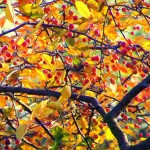If you are trying to figure out ways to produce more food from your yard, think about planting a few fruit trees. Just a few trees can produce enough fruit to last you for many months. Growing tree fruit in your backyard, however, does take considerably more room than growing berries.
Most fruit trees sold these days are on semi-dwarf rootstocks and require a minimum of 12 feet by 12 feet. Homeowners can buy trees on dwarf rootstocks and crowd them in to an 8-foot by 8-foot square. If you are looking to buy some fruit trees, make sure you don’t get full or standard-sized trees. Those trees require a lot more room and will be much more difficult to train, prune and spray. If you already have fruit trees in your yard, let me give you a few hints how to take care of them during the winter.Pruning is the major winter activity with fruit trees. You should do the majority of the pruning in January or February, when trees have lost their leaves and are dormant. In their first four to five years, most of the pruning will be light, with the focus on training.
If you train your trees correctly, very little pruning will be necessary each year. The recommended training form for apple and pear trees is called a central leader form. The idea is to create a Christmas tree shape, one main trunk and branches coming off the trunk at about 60-degree angles, growing outward. The lowest branches on the tree are the longest, and as you go higher, the branches keep getting shorter. This allows excellent light to hit all areas of the tree. In most years you will just thin out aggressive new branches to retain this shape.
When training or pruning stone fruit trees (cherry, peach, plum, prune, apricot) you will want to create an open vase form. Most of the main branches rise off the trunk from 18 inches up from the ground to about 30 inches where the tree was topped when young. The young tree has four to five branches that grow outward in all directions around the trunk, but the center of the tree is always kept open to sunlight. The outward growing branches will have fruiting wood that gets good sun from the top and outer canopy.
When pruning these trees, you will want to thin out excessive new wood to maintain good light and reduce the potential fruit load that can cause limb breakage. Pruning is a big step to getting quality fruit by opening the tree’s canopy to light, reducing fruit load, and making the tree easily accessible for spraying and fruit thinning in the late spring.
Good luck and have fun!
Disclaimer: Articles featured on Oregon Report are the creation, responsibility and opinion of the authoring individual or organization which is featured at the top of every article.


